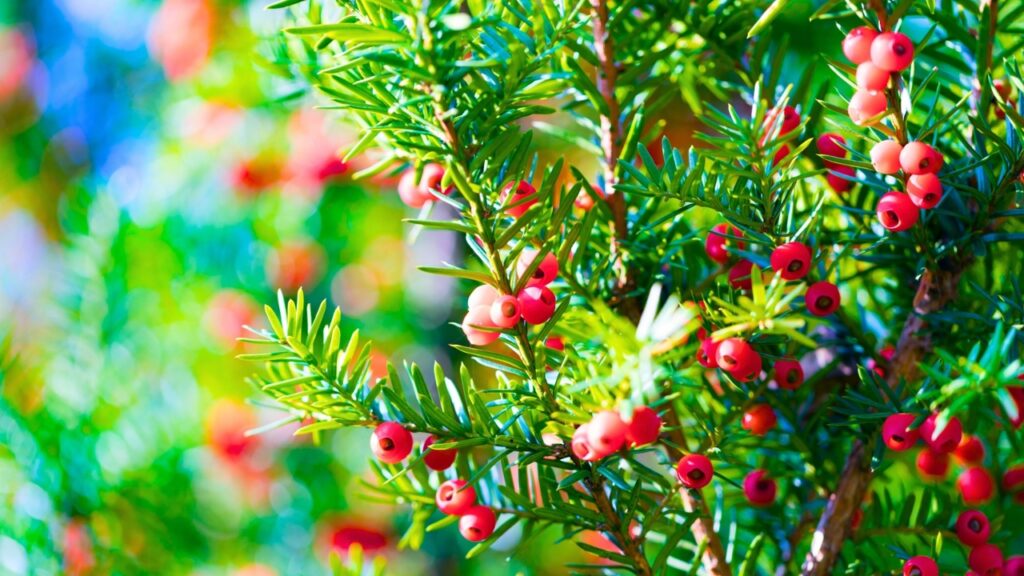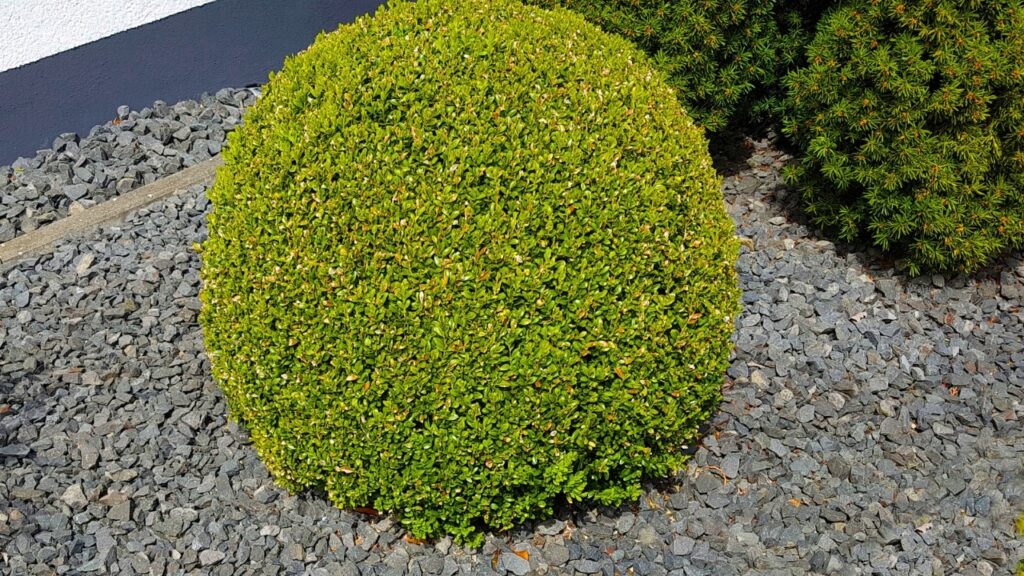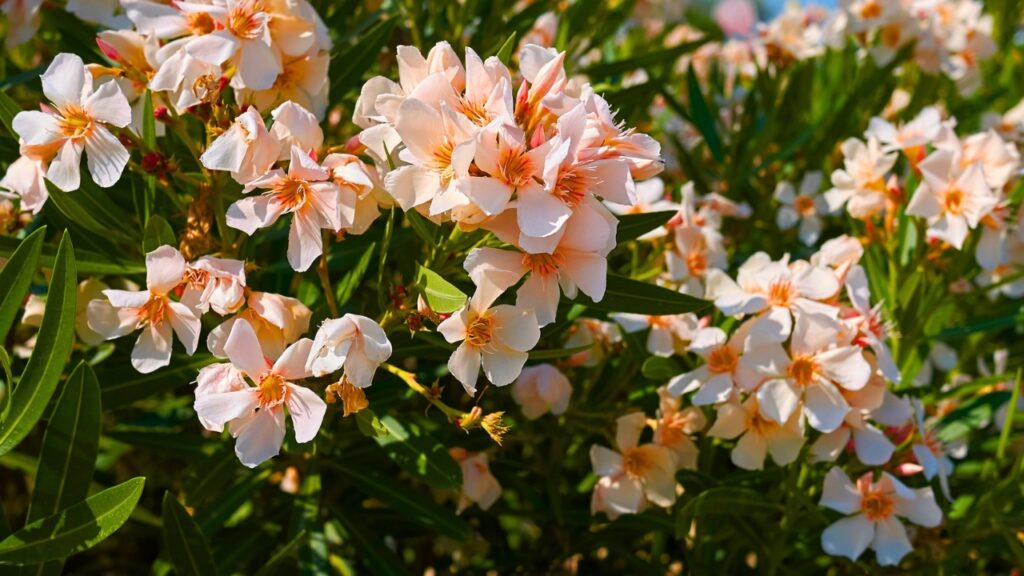The blooming bushes and leaves with different colors will make your yard look better right away.
Planting low-care plants in front of your house is a great idea. They really are a gift from nature for busy people who want to keep their front yard looking nice.
We’re talking about shrubs that don’t mind a little drought, don’t mind the dirt or the amount of sun they get, and grow pretty slowly.
In light of this, we’ve put together a list of 18 low-maintenance shrubs that would look great in your front yard garden beds.
Do you want more planting ideas? For free gardening tips, troubleshooting tricks, and more, visit our site diybaagh!
1. Hydrangea

Because hydrangeas bloom for a long time, they will give your yard a beautiful splash of color all summer. When the pH of the earth changes, their color can change from pink to blue.
Do not remove the spent flowers from your bush until mid to late fall. This will give your yard some texture over the winter.
3–9 on the USDA map
Grows to be 2 to 20 feet tall and 2 to 6 feet wide.
Full or partial sun exposure
You need soil that is moist, drains well, and has a pH mix of acidic, neutral, and alkaline.
2. BeautyBerry

The purple berries of the beautyberry plant, which lives up to its name, put on a beautiful show in the spring and summer. You can put some of these shrubs near your house because they do well in some shade. Just remember that you might need to cut them back when they get too tall.
6–10 on the USDA map
3–6 feet tall and 3–6 feet wide when fully grown.
Sunlight: From full sun to some shade
Loamy, clay, moist, and well-drained soil is what plants need.
3. Yew

Yew is another plant that doesn’t mind where it grows too much. Plants of this type, especially ones that don’t get very tall, are often found around the foundations of houses. It doesn’t need much care; you only need to water it occasionally and fertilize it once a year.
2–10 on the USDA map
Adult Size: 4 to 60 feet tall and 4 to 20 feet wide
Sun Exposure: Full to some sun
Soil Preferences: Loamy, well-drained soil with a slightly acidic pH level
4. Indian Hawthorn

Another beautiful flowering plant that doesn’t need much care is the Indian Hawthorn. Since it needs full sun, put it somewhere open, like next to a sidewalk or away from trees. Also, the bush grows slowly, so you won’t have to cut it back and forth too often.
8–10 on the USDA map
3 to 6 feet tall and wide when fully grown.
Full exposure to the sun
That the soil is moist, drains well, and has the right amount of acidic, neutral, and alkaline pH.
5. Caper Bush

The blooms of capers make a garden bed look nice and give food a nice taste boost. This bush needs to get a lot of sunlight. Just make sure to plant it somewhere with enough light, and you won’t have to think twice about it. Caper bushes actually like it when you don’t water them very much.
8–10 on the USDA map
2–3 feet tall and 3–6 feet wide when fully grown.
Being in the sun: full sun
The soil needs to be well-drained and have a pH range between neutral and acidic.
6. Pinkberry

Many people know Pinkberry for its beautiful pastel-colored berries. But its blue-green leaves that look like coins are also a show-stopper and look great when they are cut up. This shrub can handle cold weather because it is pretty tough and sturdy.
3–7 on the USDA map
3–4 feet tall and 3–4 feet wide when fully grown.
Sun Exposure: Full to some sun
Soil should drain well and have a normal pH level.
7. Boxwood

Even in the dead of winter, boxwood will keep your front garden beds looking healthy because it is an evergreen shrub. You can make this bushy plant into almost any shape you want, from a hedge to a round topiary. They do well in both full sun and partial sun, so where you put them shouldn’t matter.
4–9 on the USDA map
Grown up to be 2 to 8 feet tall and wide
Full or partial sun exposure
The soil should be sandy and have a pH level between normal and alkaline.
8. Weigela

Butterfly and hummingbirds love the pretty pink flowers that weigela has in late spring and early summer. This bush will grow 13 to 24 inches a year until it’s fully grown, so put it somewhere you don’t mind being covered. You will have to trim it quite often if you don’t.
4–8 on the USDA map
6–10 feet tall and 9–12 feet wide when fully grown.
Being in the sun: full sun
Soil should be wet but drain well, and its pH level should be acidic.
9. Dwarf Alberta Spruce

Do you want to add some evergreen to your front garden but don’t want something that will get too big? The Dwarf Alberta Spruce is a great choice. The tallest part is only 13 feet high. It’s also a great thing to use as a prop for a Christmas light show.
3–6 on the USDA map
10–13 feet tall and 7–10 feet wide when fully grown.
Being in the sun: full sun
Soil needs to be moist but drain well, and its pH level should be between acidic and neutral.
10. Azalea

Azuleas are very pretty plants that will make people really notice your front lawn. To match your other plants, you can choose from pink, white, red, purple, and yellow. If you live somewhere that gets a lot of rain in the spring, you shouldn’t have to water them to make them grow.
5–9 on the USDA map
3–20 feet tall and 3–20 feet wide when fully grown.
Sun Exposure: Some, All
Soil needs to be well-drained and have a low pH level.
11. Variegated Pittosporum

Variegated pittosporum has a maximum height of eight feet. Pittosporum, which is distinguished by its creamy white-and-green foliage, softens the waxy-green shrubs around it.
“The huge ones can be used as a hedge or border, but their billowy appearance makes them lovely as a stand-alone plant. The little white blossoms of the shrub have an orange-blossom scent in the spring.
Preference for light: full or partial sun
12. Viburnum Sandankwa

Sandankwa Viburnum can grow 6 to 12 feet and has an organic, spontaneous growth pattern comparable to variegated pittosporum. This viburnum is content to be the center of attention or to be a part of a border, hedge, or privacy screen. It has huge, rounded leaves that have a leathery, rough texture, and delicate white flowers that punctuate the foliage.
This evergreen is ideal for coastal settings since it grows well in wet, well-drained soil and can withstand salt and wildlife.
Preferred light conditions: full sun, partial shade
13. Luyken Otto Laurel Cherry

Otto Luyken cherry laurel, sometimes referred to as English laurel, is a popular large shrub that has laurel-like, shiny evergreen leaves and white cup-shaped flowers. I adore it for the same reason that I adore viburnum: the contrast between its soft foliage and its somewhat stiff branches.
14. Elias

A tried-and-true staple in Southern gardens, abelias does require annual pruning, but it’s well worth the effort thanks to its graceful branches and gorgeous bell-shaped summer through fall flowers.
The abelia is a member of the honeysuckle family and comes in a variety of heights and bloom colors. Choose dwarf types of abelias to fit in a smaller location, as they can grow up to 8 feet tall.
Preferred light sources: full sun and partial shade
15. Dappled Tri-Color Willows

Willows with mottled color in three shades like a bushy version of a bridal bouquet. Reaching up to 8 to 10 feet, the bush has rounded, willowy-like branches with pink, white, and green tinges.
Preferred light sources: full sun and partial shade
16. Plum Yew

The texture-rich, serrated leaves of the low-growing plum yew shrub spread throughout a landscape, resembling ferns. It’s an excellent choice for a border or second row since it provides height and elegance at the same time. The plum yew is more wide than tall and looks good in forested settings.
Light preference: deep shadow, moderate, and full sun in areas with cold summers.
17. Distilium

Distylium is a great choice for planting on low-lying areas or slopes because of its strong yet soft evergreen foliage with tightly spaced branches. Distylium, a plant that embodies minimum maintenance, appears to be immune to pests, diseases, and deer. With little to no trimming, they also maintain their original form and remain compact.
Preferred light sources: full sun and partial shade
18. Miscanthus Grass

The word miscanthus, which translates from Greek to mean “stalk and flowers,” refers to a collection of grasses that comprise roughly twenty species. Utilizing ornamental grasses has the advantage that they maintain their shape all year round and provide the landscape a lovely structure—despite not strictly being considered shrubs.
Preferred light sources: full sun and partial shade
19. Chinese Indigo

Chinese Indigo grows to a height of approximately 2 feet and a width of 3–4 feet. It is typically used for indigo-colored dye. Its lavender flowers in early June have a wisteria-like appearance, which makes it a pollinator-friendly plant for well-draining soils.
Preferred light sources: full sun and partial shade
20. Holly Inkberry

It’s quite simple to take care of this evergreen shrub that grows slowly. To ensure that your Inkberry Holly plant bears fruit, place female shrubs close to one or more male shrubs, which will serve as pollinators.
USDA Regions 4–11
Mature Dimensions: 5–10 feet high and 5–10 feet broad
Sun Exposure: From direct sunlight to some shade
Soil Requirements: Acidic, moist soil
21. Juniper

Juniper plants are drought-tolerant, evergreen bushes that can fend for themselves. It also doesn’t require frequent fertilization, and the only pruning it requires is the removal of any dead leaves.
USDA Regions 2–7
Mature Size: Depending on the species and cultivar, this can range from 6 inches to 15 feet tall and 1 to 12 feet wide.
Sunlight Exposure: Direct sunlight
Requirements for Soil: Sandy, well-drained soil with an acidic, neutral, or alkaline pH
22. Viburnum

For good reason, viburnum is a favorite landscaping shrub for both front and backyards. It doesn’t care too much about the growth environment and is available in a wide variety of hues. Consider ‘Spring Bouquet,’ which only grows to be 3 to 5 feet tall, if you want a variety that grows slowly and requires less pruning.
USDA Regions 2–9.
Mature Size: Depending on the species and cultivar, this can range from 3 to 20 feet tall and 3 to 12 feet wide.
Sun Exposure: Complete or partial
Soil Requirements: Neutral or acidic pH, moist, well-drained soil
23. Lavender in English

English lavender has a very calming scent, and its blooms can be collected and dried. Aside from all those advantages, once it establishes itself, it tolerates drought well, making it an excellent shrub for the front yard.
USDA zones: 5–9.
Mature Size: 2-3 feet broad by 1-2 feet tall
Sun Exposure: From direct sunlight to some shade
Loamy, sandy, silty, well-drained soil with an alkaline, neutral pH balance is required.
24. Miss Kim Lilac

Another fragrant flower that looks beautiful in the front yard is the lilac. Its leafy shrub persists after the spring blooming season ends. Miss Kim requires less trimming because it reaches a shorter mature height.
USDA zones: 4–8
Mature Dimensions: 6–8 feet broad and tall
Sunlight Exposure: Direct sunlight
Loamy soil with a pH range of neutral to slightly alkaline is required.
25. Oleander

If you’re itching for a vibrant front yard, oleander is a fantastic choice. It blooms for a long time—sometimes well into the early fall. Plant this plant where you want a live privacy screen, perhaps on the side of your porch, as it grows quite quickly.
USDA zones: 8–10.
Mature Size: 8–19 feet high and 6–10 feet broad
Sun Exposure: Complete or partial
Fertile, flexible soil with an alkaline pH balance is required.

